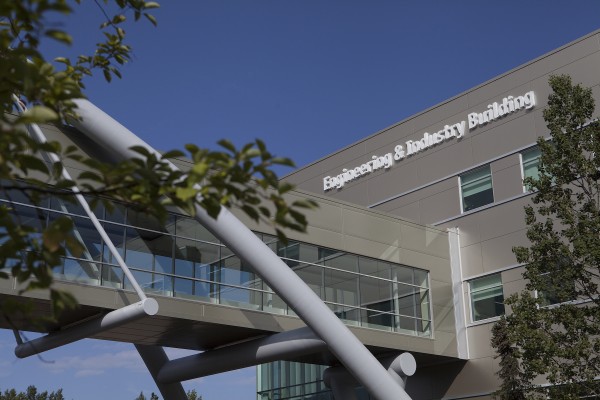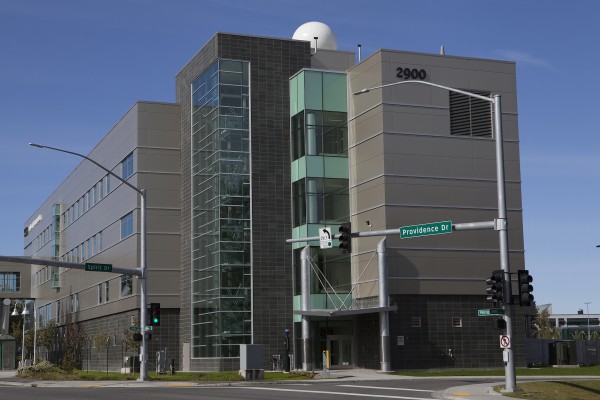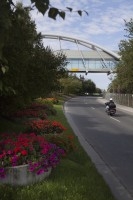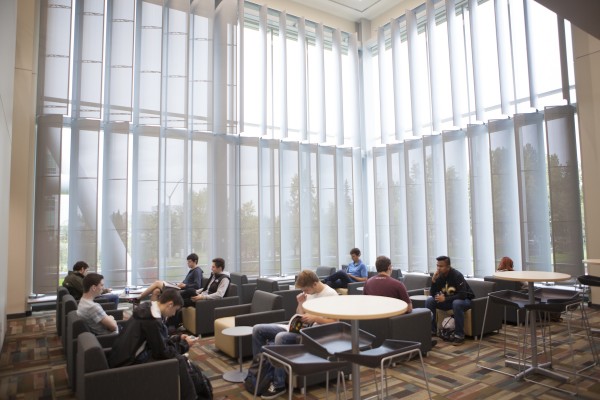Engineering & Industry's ins & outs
by joey |

The Engineering & Industry Building is a "wired to the hilt" educational space providing much-needed breathing room for the constantly booming College of Engineering. (Photo by Philip Hall / University of Alaska)
No square foot is spared in the new Engineering & Industry Building (EIB). Located just yards away from the Student Union, the new central building highlights engineering in action at every opportunity. From the exposed systems to the wall monitors to the big fiberglass golf ball on the roof (it's called a Radome, used for testing radio frequency equipment) the new facility is an eye-catching-and much-needed-academic addition.
The original Engineering Building first opened in 1983, when both the College of Engineering and UAA were much smaller operations. As UAA enrollment grew, the original building could no longer hold the exploding number of engineering majors. For context, in 2000, the College of Engineering's enrollment was 305 students. Enrollment had quadrupled to more than 1,250 registered students last fall.

Research started in the EIB before it even officially opened. UAA Assistant Professor Jifeng Peng, left, and Zachary Garcia, a UAA mechanical engineering graduate student, are conducting National Science Foundation-funded research into vortex rings. (Photo by Philip Hall / University of Alaska Anchorage)
Recent graduates may remember the program's evident growing pains. Labs were repurposed for multiple disciplines (as well as storage) and students squeezed inside, sometimes leaning against workbenches while taking notes for class.
Things, thankfully, have changed. The new 81,500-square-foot building triples the amount of engineering space on campus. In early design stages, architects consulted with faculty to draw up a wish list of possible features, then tried to fit in as much as they could muster. The final product is a major benefit for current students. "We're primarily an undergraduate teaching institution so a lot of the lab space was designed around teaching, not necessarily [graduate] research," explained assistant professor Scott Hamel. That means research opportunities are much more available for interested undergrads than at other state universities.
The entire building is a classroom-even the staircase was designed with a four-story gap so students could drop materials for impact tests. Expanded cold rooms allow for larger arctic research projects at -30°C while massive flumes let coastal engineers test materials. Student clubs have a cavernous two-story space where they can build electric dune buggies and concrete canoes to compete at nationwide engineering contests. There are 3-D printers and small-scale wind tunnels and the entire building is "wired to the hilt," as Hamel explained. Additionally, elements of the building's inner workings are exposed as "engineering on display," allowing professors to show students how course materials are in play all around them.
And not just students are benefiting. "There's a huge demand for a facility like this in the state," Metzger added, citing Alaska's one-and-only strong floor that has already netted corporate contracts. Prior to the building, companies would have to ship their multi-ton projects out of state to test the load-bearing abilities of their materials. Now, they can just bring them to campus, saving time and money and giving UAA students hands-on paid research opportunities. One company even waited two years for the strong floor to open so they could test their Alaska-manufactured products in state. That demand has resulted in an immediate flurry of activity in the new building. Faculty and student researchers have shared the space with contractors for months.

Middle school students study wing aerodynamics in the EIB's wind tunnel during UAA's Summer Engineering Academies in August. (Photo by Tracy Kalytiak / University of Alaska Anchorage)
Alumnus Mike Fierro, B.S. '89, M.S. '01, served as lead structural engineer on the EIB (as well as the Health Sciences Building, ANSEP Building, the addition to the UAA/APU Consortium Library and several other recent additions along Providence Drive). For his immense contributions to the design of the campus, Mike will be honored in the College of Engineering Alumni Hall of Fame, another new addition to the department (look for it on the second floor). Joining him in the inaugural class is Sam S. Kito III, B.S. Civil Engineering '88, a current state representative for Juneau and an original staff member of the Denali Commission, where he helped develop programs for funding infrastructure and economic development projects in rural Alaska. The induction ceremony takes place at 6:30 p.m. on Sept. 10, following the ribbon cutting.

The new 81,500-square-foot building triples the amount of engineering space on campus. (Photo by Philip Hall / University of Alaska Anchorage)
A Providential bridge

The creatively-designed 230-foot bridge over Providence Drive connects two of the newest campus buildings. (Photo by Philip Hall / University of Alaska Anchorage)
But let's not overlook that big beautiful bridge. In a world of blocky buildings, the newest span of the Spine is certainly a change of pace.
The new gateway bridge went into place over winter break and is already an iconic landmark of UAA-the unique arches were quickly adopted into the College of Engineering's logo. The bridge links two of campus's most recent buildings (the new EIB and the Health Sciences Building, opened in 2011).
UAA tapped the architects of Livingston Sloane and the engineers of Reid Middleton to design the bridge, requesting a visual gateway that celebrated the new generation of campus. After reviewing suggestions, UAA Facilities opted for the iconic double-arched walkway-a design that was clean, visual and completely rooted on campus.
The bridge was also-surprise?-designed by Mike Fierro. As an engineer, he's used to having his structural handiwork completely cloaked by the architects he works with. But this time, the architects were happy to let the bones of the building show. "How many engineers get to do an arch?" he laughed.
While students headed home for winter break, the team moved into action. For several days, construction crews moved massive steel beams into place under the watchful eye of a glimmering Christmas tree in the median. Once installed, the angled beams were welded smooth-the bridge has no exposed bolts aside from the base, minimizing the university's upkeep in the future. View a time lapse video of its construction here.
Visually, the 230-foot span adopts design elements of both its neighbors. The steel structure matches the silvery shimmer of the health building, while the insulated metal panels carry over onto the new engineering building.
Style aside, the span is also an impressive engineering feat. Unlike other stretches of the campus Spine, this newest bridge is completely self-supported and structurally independent of its neighboring buildings. Much like a backyard swing set, the dual leaning arches provide stability against wind and seismic activity (although the underground anchors buried 12 feet deep help, too).
The dual arch gateway completely clears Providence Drive without requiring an additional central support. The walkway offers 23 feet of clearance over the street and is entirely rooted on campus property.
"This was an incredibly unique opportunity and as a team we've all been thrilled and honored that the university gave us this opportunity," said Paul Daugherty, architect with Livingston Slone. "We'll never see anything like this again in our careers."

The EIB's two-story student lounge includes the new eXpress coffeeshop. (Photo by Philip Hall / University of Alaska Anchorage)
Next steps
As the EIB opened, the original Engineering Building closed its doors... but only temporarily. After a major renovation, the former building will reopen in Fall 2016 with even more benefits for student engineers. Geomatics students will have enough space to move their surveying projects indoors. Classrooms will be reformatted with circular tables to build a collaborative learning environment and, like the new EIB, the original building's redesign will also increase the focus on providing distance education.
All in all, the building is a boon to UAA's constantly expanding cadre of future engineers. Labs sprawl across the ground floor, allowing for constant collaboration among projects, while a comfortable second floor lounge provides a sun-soaked respite near the faculty offices. But it's the hands-on involvement students should be most excited about.
"There weren't nearly as many opportunities to experience engineering before, and that [gap] was multiplied if you were interested in research," Hamel noted. "Now, if you're interested in doing undergraduate research, there will be huge opportunities."
Written by J. Besl, UAA Office of University Advancement
 "Engineering & Industry's ins & outs" is licensed under a Creative Commons Attribution-NonCommercial 4.0 International License.
"Engineering & Industry's ins & outs" is licensed under a Creative Commons Attribution-NonCommercial 4.0 International License.














